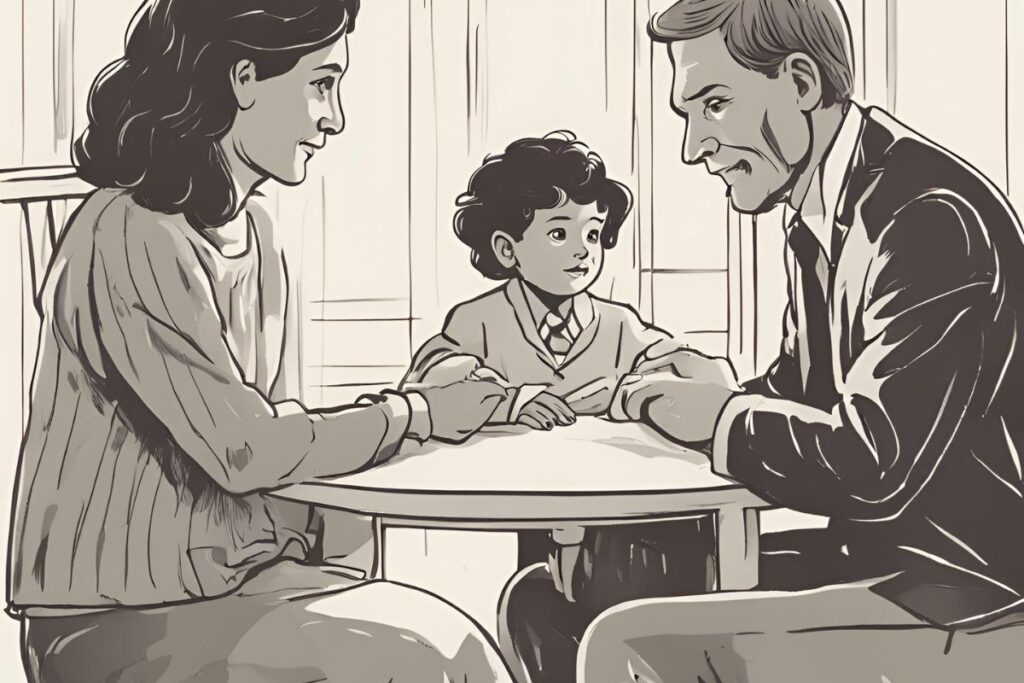If you’re finding it tough to get along with your child, reunification therapy might be just what you need. It’s like having a coach to guide you through rebuilding your relationship. Let’s dive in and learn more about this special kind of help.
What is Reunification Therapy?
You know how sometimes parents and kids just can’t seem to see eye to eye? Reunification therapy helps families where a child and one parent are having trouble getting along. It can happen after a separation or divorce, and the goal is to rebuild the connection and create a safe space for everyone to talk things out.
Why Reunification Therapy Matters
If you’re a parent looking to reconnect with your child, or if you’re just curious about this type of therapy, you’re in the right place. Reunification therapy can be a game-changer for families going through tough times, and it’s all about creating a safe and supportive environment for everyone involved.
Controversies Surrounding Reunification Therapy
- Critics worry that making a child spend time with an abusive parent could harm their safety and well-being.
- Sometimes, it’s hard to tell if a parent is genuinely abusive or if the other parent is unfairly turning the child against them.
- Reunification therapy might not work well when there are serious family problems or if a parent has mental health issues.
- Forcing a child to see a parent they fear or reject can cause more emotional harm.
- There isn’t enough strong evidence yet to show how well reunification therapy works in the long term or the best ways to do it.

How Reunification Therapy Gets Started
You can start reunification therapy in two main ways:
1. Court-Ordered
In contentious divorces or custody disputes, a judge may mandate reunification therapy when a child is refusing contact with one parent. The goal is to address underlying issues and rebuild the parent-child relationship in a safe and supervised setting.
2. Voluntary
If you’re concerned about a strained relationship with your child, you can independently seek out reunification therapy. Taking this proactive step demonstrates a commitment to improving family dynamics and can benefit everyone involved.
Working with a Reunification Therapist
Connecting with a reunification therapist involves a few key steps:
- Initial Assessment: The therapist will likely begin with individual sessions with each family member to understand everyone’s perspective on the situation and assess the dynamics at play.
- Setting Goals: Together with the therapist, you’ll establish clear goals for reunification therapy, such as improving communication, rebuilding trust, or establishing healthy boundaries.
- Communication Skills: The therapist will likely teach communication skills to all family members, such as active listening, expressing feelings constructively, and resolving conflict peacefully.
- Individual and Family Sessions: The therapist might alternate between individual sessions (focusing on personal growth) and family sessions (working on communication and interaction as a unit).
- Taking It Day by Day: Reunification often happens in small steps. The therapist will guide the pace of reintroducing contact between the child and parent, ensuring everyone feels safe and comfortable.
- Homework: The therapist might assign exercises or “homework” to practice the skills learned in therapy outside of sessions.
When Reunification Therapy May Not Work
Sometimes reunification therapy may not be the best choice, and that’s totally okay. Here are a few reasons why it might not be the right fit:
- Documented Abuse: If there’s clear evidence of abuse by the parent, it’s better to focus on the child’s safety and well-being first.
- Severe Mental Health Issues: If the parent has serious untreated mental health issues, it might hinder their ability to create a safe environment for the child.
- Extreme Parental Alienation: In cases where the child has deep-seated fear or distrust of a parent, other therapeutic approaches might be necessary first.
- Lack of Willingness: If either the parent or the child isn’t on board with therapy, it’s unlikely to be successful.
- Advanced Estrangement: If the estrangement has been ongoing for a long time, especially with older children, reunification therapy might not be the most effective approach.

Who’s Involved in Reunification Therapy?
In this process, there are a few key people you can expect to be involved:
- You: Your voice and perspective are super important throughout the therapy.
- Parents: Both parents or the parent looking to rebuild the connection with the child will be involved. Everyone needs to be actively committed.
- Reunification Therapist: This is a mental health professional trained in family therapy and reunification techniques who will guide the process.
Purpose of Reunification Therapy
The main goals of this therapy are to:
- Strengthen the relationship between you and your parent.
- Address past conflicts that led to the estrangement.
- Teach active listening and constructive expression of feelings.
- Establish clear, respectful boundaries within the family.
- Focus on emotional healing for both you and your parent.
Steps in the Family Reunification Process
So here’s what you can expect in the process:
- Initiation: This can be court-ordered or initiated voluntarily by a concerned parent.
- Evaluation and Assessment: The therapist will meet each family member individually to understand perspectives and assess the situation comprehensively.
- Goal Setting and Planning: Together with the therapist, you and your family will establish clear, achievable therapy goals.
- Therapeutic Intervention: You’ll focus on enhancing effective communication skills and have both individual and family sessions.
- Homework: Expect some exercises to reinforce communication skills and address underlying family issues outside of therapy sessions.
- Gradual Progress and Monitoring: The therapist will guide the gradual reintroduction of contact between you and your parent, ensuring comfort and safety.
- Potential Outcomes: The aim is to achieve physical reunification with regular contact between you and your parent, but success can also be measured by enhanced family interaction and healthier relationships.
When is Reunification Therapy Not Recommended?
You’ve got to put safety first. If there’s documented abuse, going through reunification therapy could actually end up retraumatizing the child. Similarly, if one of the parents is dealing with some serious mental health issues, it might be best for them to get the help they need before trying to rebuild the relationship.
If there’s extreme alienation or one of the parents, or even the child, isn’t really on board with participating, it can really slow down the progress. In cases of long-term estrangement, especially with older kids, there might be other approaches that could work better.
Therapists take into account the child’s age, how severe the situation is, and the family’s support system before deciding if reunification therapy is the right path.
Who Typically Covers the Costs of Reunification Therapy?
- If court-ordered, judges often split the cost between parents, though sometimes they consider income and have one parent pay more.
- Voluntary therapy usually means parents cover the cost themselves, splitting it however they agree or one parent paying entirely.
- Insurance might chip in, and some therapists offer sliding scale fees based on income.

How Does Reunification Therapy Handle Cases Involving an Abusive Parent?
If there’s documented abuse, then therapy isn’t the way to go for now. The focus needs to be on the child’s healing, possibly through individual therapy.
If the abusive parent has worked on their issues and the child feels safe, then supervised visits might be an option down the line. Otherwise, therapists might look into other ways to support the child and the non-abusive parent.
What is the Success Rate of Reunification Therapy?
There’s a study that found about 82.7% of children remained reunified at the end of the study. But it’s important to note that success rates can vary, and more research is needed. Also, around a quarter of reunified kids were reported to child protective services again, but we don’t know for sure if that’s linked to the therapy.
What Happens If Reunification Therapy Doesn’t Work?
If reunification therapy doesn’t work out, the focus stays on the child’s safety. Therapy might shift to support the child or explore other approaches for the family, like communication skills training or educational programs. In court cases, custody arrangements might be revisited. But even without full reunification, there can still be success, like better communication and reduced conflict.
How Long Does Reunification Therapy Usually Take?
Reunification therapy is a slow process, no magic answer for how long it takes. It depends on how long the estrangement lasted, the child’s age, how committed everyone is, and any underlying issues. It can take months to over a year, but even small improvements like better communication are signs of progress.
Is Reunification Therapy Covered by Insurance?
Insurance coverage for reunification therapy can be a bit tricky. Private plans are more likely to cover it than government programs. You’ll need to check your plan details. Court-ordered therapy might have a better chance of coverage than voluntary therapy. It’s best to call your insurance company directly to understand your specific coverage and any out-of-pocket costs.
Where Can You Get Reunification Therapy?
You can get reunification therapy online from PsychiCare at locations including Portland, Lewiston, Bangor, South Portland, Auburn, Biddeford, Augusta, Scarborough, Saco, Westbrook, Brunswick, Sanford, Gorham, Windham, Waterville, York, Falmouth, Kennebunk, Orono, Presque Isle, London, Birmingham, Manchester, Edinburgh, Glasgow, Miami, Orlando, Tampa, Jacksonville, Tallahassee, Los Angeles, San Diego, San Francisco, Sacramento, Seattle, Spokane, Denver, Colorado Springs, Chicago, Springfield, Boston, Worcester, Houston, Dallas, Austin, San Antonio, Philadelphia, Pittsburgh, Minneapolis, St. Paul, Duluth, Indianapolis, Columbus, Cincinnati, Cleveland, Boise, Las Vegas, Santa Cruz, Vancouver, Vancouver WA, Edmonton, Alberta, Gold Coast, Sydney.




